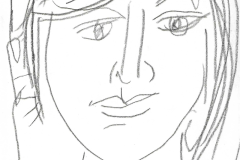Testimonial Christian Cornu
Testimonials on the work of Blasco Mentor by Daniel SIMONIN
——————————-
 My house and my work reflect the same vision: the taste for celebration and mockery – Quote from Mentor in the magazine “Residence” number 5 of March-April 1955 p.82 or 8 pages are devoted to the home of a conquistador.
My house and my work reflect the same vision: the taste for celebration and mockery – Quote from Mentor in the magazine “Residence” number 5 of March-April 1955 p.82 or 8 pages are devoted to the home of a conquistador.
A painting only exists by you and as many times as you see it – Mentor’s quote on the cover page of an Art book by Osvaldo Patani, opere dal 1935al 1986 published in 1986 in Milan.
——————————-
Blasco Mentor, born in 1919 studied painting at the School of Fine Arts in Barcelona, an exceptional student, he painted at the age of sixteen the portrait of his brother naked and in Harlequin clothes.
Refugee in France, fleeing the war in Spain, he joined the School of Paris and after the war he was supported by great art critics who saw in him a great creator, an observer of human comedy. the time when Western painting abandoned the representation of man.
For Waldemar George (1893-1970) critic and art historian, editor-in-chief of literary reviews, the world of Mentor imposes itself both by the extreme rigor of its cadence, by its forms projected in close-up and by his imagery but also by the taste of the fairyland and the feeling of reality which coexist in his work.
For the latter, “La Fête à Solliès-Toucas”, painted in 1960, is Mentor’s masterpiece. Heir by his Spanish roots to the universe of Goya and picaresque tales, Mentor painted the spectacle of human theater and its sufferings as the paintings “Spain 36-39” and “Bombardment in Viet Nam” bear witness to this.
Art critic Jean Rollin (1922-2006) becomes Mentor’s friend and thanks to him he paints a monumental 400 m2 mural at La Courneuve, designed on the theme of “The Conquest of Happiness”.
Warmly welcomed in Italy, in 1973 he composed a monumental fresco at the Palazzo Castiglione in Milan entitled “La Grande Fête”.
Mentor’s work is addressed to lovers of color and celebration, so in the paintings of “The Great Parade” he paints with delight a satire of human society, its vices and its eccentricities and in the great canvases devoted to “Bullfighting” the man is placed in a tragic and derisory world, he is sometimes a painter, musician, bullfighter, disguises himself, fights bulls on wheels, rides magnificent steeds … on a merry-go-round, so that some have considered that his art reminded one of Fellini.
An important exhibition “La Minotauromachie” at the Artcurial gallery was celebrated as the staging full of inventiveness and richness of human comedy. The “Divertimento” exhibition is a parody of the circus where wild animals, rhino elephants, lions are tamed and have a blast, and where gentle doves spread sublime poetry.
Mentor was recognized by the political class of his time: a retrospective of his work at the Vasarely Foundation will be inaugurated by the Minister of Culture and in 1991, at the invitation of the City of Paris, his works will be exhibited at the Bourdelle Museum.
Painter of the Guigné gallery, Mentor multiplied his exhibitions in the 1990s, with a palette that never stopped evolving towards light colors and a freedom of expression due perhaps to the discovery and practice of sculpture. .
“The Bird Carnival” is a tribute to Venice, but also to the Woman who throughout her life has been a model for Mentor’s paintings. Most often the women are painted plump, sometimes mameluos and callipyges. In the Carnival of Venice the birds wear Venetian masks and the naked women stand out more than ever in volume.
But the eternal feminine, according to Mentor, is a face that is sometimes haughty and proud, a mocking or disdainful expression, insensitive to the love of the man who courts her, quite the opposite of the sensuality released by an always voluptuous body.
“Les Concertistes” is a dream in powder paint, a celebration of spirit and color, critics will say.
In “La Fenice”, his latest exhibition, Mentor gives a sensual vision of the most famous city in the world, always with this profusion of colors, this exuberant enchantment and this poetry that made Mentor, according to Hervé Bazin:
The great painter of the Baroque, and one of the last Catalan princes of painting, whom Picasso considered to be one of his legatees of modern art.
Source: Daniel SIMONIN (friends of the Blasco Mentor work)


